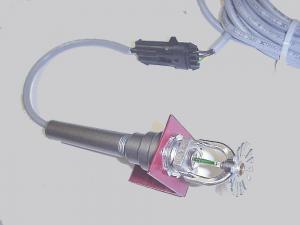2009 - Volume #33, Issue #6, Page #40
[ Sample Stories From This Issue | List of All Stories In This Issue | Print this story
| Read this issue]
Heat Sensors Detect Fires Before They Start
 |
"When it detects a preset temperature, it sets off an alarm," says Ralph Kennerknecht of Global Aerotech, Inc. "It's 105 decibels, more than enough to wake most people or get their attention. Once you get to the control panel, which can be mounted anywhere, you can see which sensor is detecting the heat and deal with it before a fire breaks out."
Kennerknecht is initially targeting the motor home industry, but sees countless other applications such as combines and other farm equipment. Though the Heat Scope has only been on the market a few months, sales are exploding. He reports selling $24,000 worth of the units in only four days at one show.
In motor homes, he recommends a 200? sensor in the engine compartment, a 175? sensor at the generator, a 135? sensor at the reefer and a 155? sensor at the electrical panel.
Kennerknecht first sold fire extinguishers that would go off automatically in case of fire. He still sells the automatic extinguishers, but says detecting a problem before a fire breaks out is even more important.
"You generally have about four minutes maximum from detection of a fire before it's beyond saving," he says. A basic setup priced at $350 consists of one thermal link or sensor and the control panel. Each additional link, up to a total of four, costs $135.
"The wires are specially coated. If a fire burns through it at any point between the sensor and the control panel, the alarm goes off," says Kennerknecht. "We're working on making the system wireless, so you don't have to run wire the length of a machine."
Contact: FARM SHOW Followup, Global Aerotech, Inc., Fire Fight Division, 2885 Electronics Dr., Suite C7, Melbourne, Fla. 32935 (ph 321 752-9096; ralphnio@bellsouth.net; www.firefight1.com).

Click here to download page story appeared in.

Click here to read entire issue
To read the rest of this story, download this issue below or click here to register with your account number.




